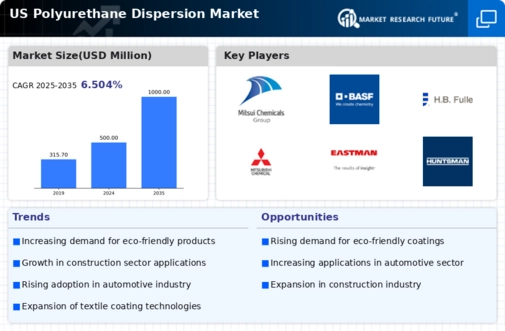The US Polyurethane Dispersion Market is characterized by a dynamic competitive landscape that is shaped by a variety of factors including technological advancements, consumer preferences, and regulatory frameworks. The market comprises several key players who are consistently innovating to meet the evolving demands. As polyurethane dispersions are widely utilized for applications in coatings, adhesives, and sealants, companies are focusing on enhancing product performance while ensuring environmental compliance.
The competitive insights reveal that market participants are employing strategies such as product differentiation, strategic collaborations, and mergers and acquisitions to strengthen their position, better serve their clients, and capture a larger market share. Innovation in product formulation and sustainable practices are becoming increasingly influential in determining the success of businesses operating within this sector.Mitsui Chemicals holds a significant position in the US Polyurethane Dispersion Market, leveraging its advanced technological capabilities and expansive expertise. The company's strengths lie in its commitment to research and development, enabling the creation of high-performance polyurethane dispersions tailored for various applications.
Mitsui Chemicals is recognized for its ability to address customer-specific needs and respond rapidly to market demands. The company has established a robust distribution network, ensuring that its products are readily accessible to industrial sectors such as automotive, construction, and electronics. Through strategic investments in sustainable practices and eco-friendly products, Mitsui Chemicals showcases its dedication to environmental responsibility, enhancing its value proposition in the competitive landscape.BASF is another prominent player in the US Polyurethane Dispersion Market, offering an extensive range of high-quality products and solutions tailored for various industries.
The company is known for its innovative approach and commitment to sustainability, with many products designed to reduce environmental impact while maintaining performance standards. BASF's portfolio includes various polyurethane dispersions utilized in coatings and adhesives, which cater to diverse customer needs. The company's strong market presence is bolstered by its strategic acquisitions and partnerships, enhancing its capabilities and expanding its reach across the US. BASF continues to invest in developing cutting-edge technologies to improve product performance and comply with regulatory requirements, solidifying its position as a leader in this competitive market.
The integration of sustainability into their operations alongside robust customer support services has further increased BASF's appeal to a wide array of industrial clients in the region.
























Leave a Comment